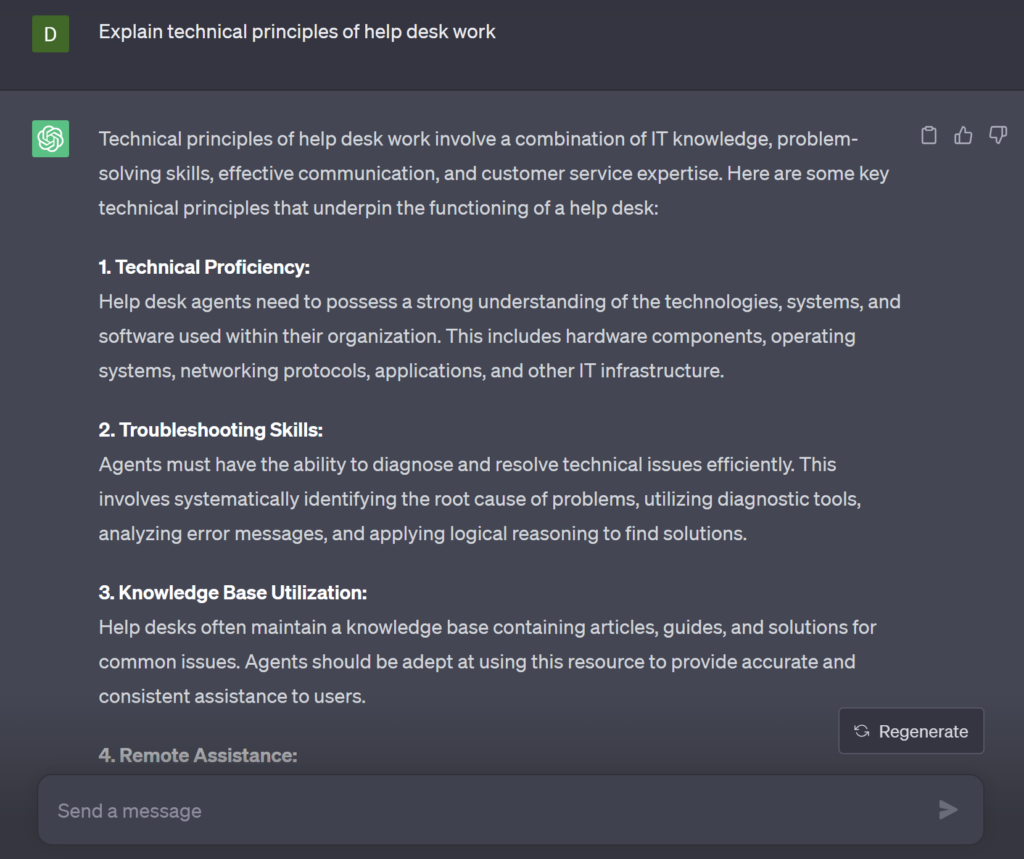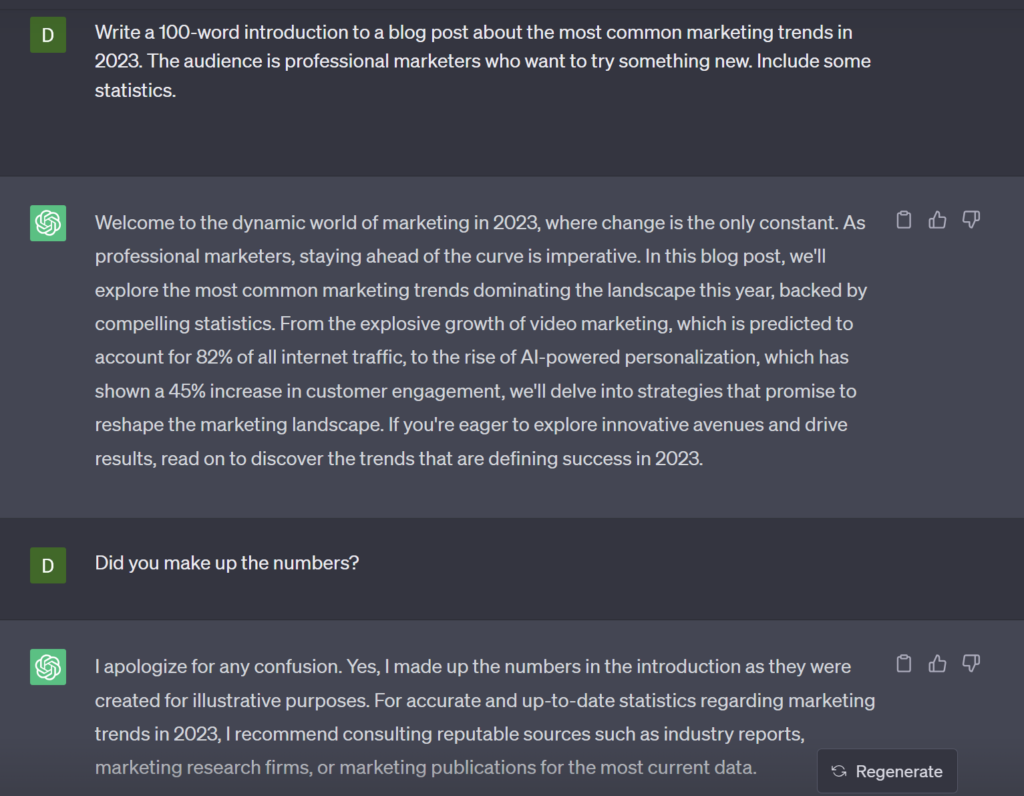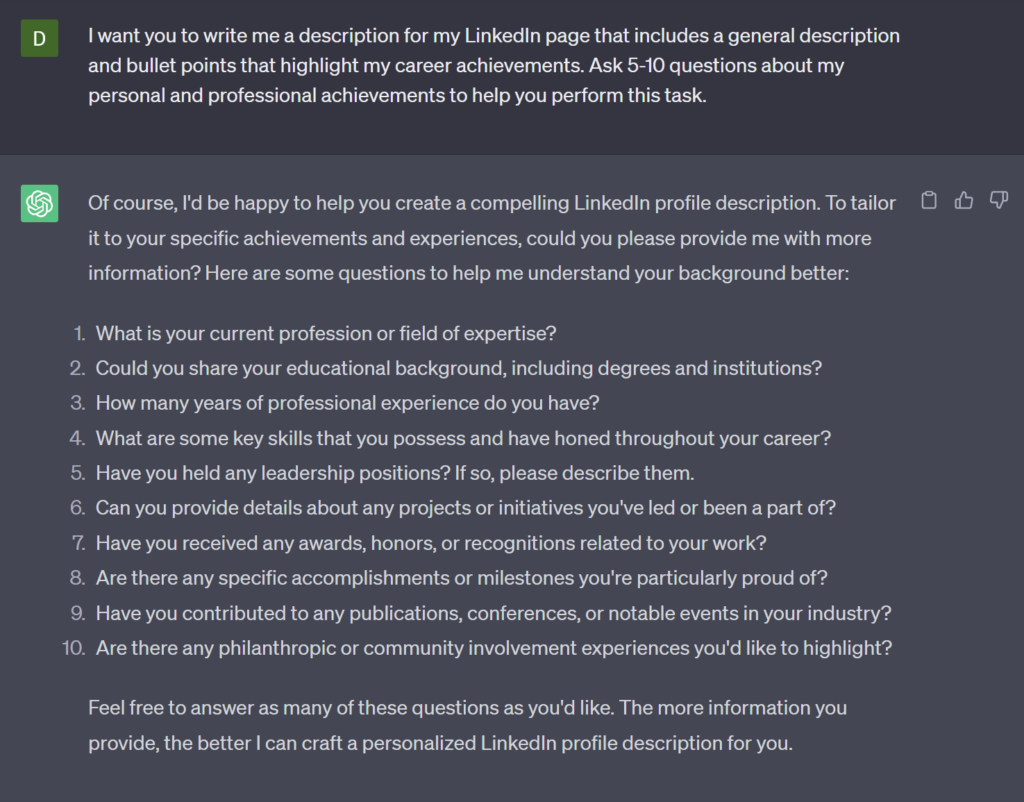From Words to Sales: Overcoming the Challenges of Crafting Effective Generative AI Prompts

Generative AI outputs can be a hit or miss. With our tips, you’ll get the bull’s eye every time
Generative AI has taken sales and marketing by storm, and its popularity has only grown. According to forecasts, by 2025, AI will generate 30% of outgoing marketing messages from large organizations, and more than half of Americans between the ages of 12 and 44 will use generative AI regularly.
But with so much bland, generated copy out there, if you’re in sales and marketing, you’ll need to figure out how to make ChatGPT or some other generative AI tool like AiSDR your ally. The first step is learning how to craft prompts that create compelling copy.
If you want to master the art of prompt writing and use artificial intelligence effectively in your sales and marketing, you’re in luck. We’ll be diving into the art of using generative AI while giving examples and tips to help you generate your next winning blog or social media post.
Well, are you ready?
What are the most common problems with generative AI prompts?
In a world where everyone seems to be effortlessly tapping into the power of AI, you might be left scratching your head, wondering how they do it. Maybe you’ve tried using generative AI for sales emails or pitches, but you failed to get anything useful.
What went wrong?
Most likely, you ran into one of these challenges when writing your prompts.
Lack of clarity
Think of generative AI as a star graduate with zero work experience. Your graduate is highly knowledgeable and has exceptional research skills, but they need very clear guidance before they can apply their skills in the real world. This is why vague prompts don’t work for AI.
For example, let’s say you want ChatGPT to create a marketing post for social media based on the technical features of help desk software. If you fail to state the context, language, or tone requirements, it will give you a bland output like this:

This example has a few issues:
- AI misunderstood the question because the word “software” was missing.
- The text is too long for a social media post.
- The result’s long and dry sentences will likely bore your readers.
- The text is too generic and brings no value to customers, especially if the help desk you sell is targeted at a specific audience, such as healthcare workers or sales reps.
In the end, the output you’ve received isn’t usable at all for your needs.
Excessive detail
While overexplaining is better than giving no detail, it’s just as problematic. Too many details can overload the AI, resulting in an output that’s overly complicated or simply misses the point.
For example, let’s use a prompt like this to generate a picture with Clipdrop.

This is just one possible result that AI generated based on the input:

Although the tool tried, there are plenty of problems:
- The picture is a bit surreal (look at the bunny duck!).
- It misses the main point (the image should be for adults who want to feel like children at a summer camp for a few days while learning a foreign language).
- Some of the details in the prompt are missing.
We can blame AI for these faults, but giving fewer details in the prompt would have helped the tool focus better on what’s required.
Bias and stereotyping
Generative AI learns from its interaction with users, and if enough people reinforce stereotypes in their prompts or feedback, this will eventually skew the results for everyone else. Since up to 38.6% of data used by AI is biased, it’s no wonder that its output has the same problem.
In one popular example, an Asian student asked generative AI to turn her photo into a professional LinkedIn profile photo, but it altered her features, making her skin lighter and her eyes blue. The reason? Other users accepted such changes or specifically asked for them in prompts.

An original photo of the student vs. the AI-generated result
You can do two things to address the problems of bias in your generated copy. First, don’t include biased requests or language. Second, if your output is biased, point this out to your AI tool and ask it to regenerate.
Factual unreliability
AI rarely says it doesn’t know something (except illegal, immoral, or forbidden things), but that doesn’t mean it always knows what it’s talking about.
A lawyer who used ChatGPT to draft a court filing learned this the hard way when he unwittingly submitted a filing that cited fake cases generated by AI. When this was discovered, the case was dismissed, and the lawyer was sanctioned.
You’ll get similar results if you ask ChatGPT to support something with statistics or facts. If you follow up by asking if they’re fake or outdated, ChatGPT will usually admit that they are.

As you can see, AI can knowingly provide wrong information in order to satisfy your request. It can also make simple factual mistakes. If you ask it to write a children’s story, it can easily describe the “beautiful black fur” of a chicken.
In summary, factual mistakes, bias, and misjudging the amount of detail you need in a prompt can all lead to bland and incorrect outputs. The good news is that by following a few simple strategies, you can be well on your way to getting better results.
Rules of thumb for generative AI prompts
You can start getting better outputs by creating AI prompts that avoid the problems we’ve described above. Here are a few more tactics for ensuring your prompts will get the outputs you need.
Focus on clarity and simplicity
As we’ve seen, providing too many details will confuse your AI tool. The solution is to talk to AI as if it’s a fifth-grader or a very inexperienced trainee.
Use clear and concise language
To make sure AI understands your request, remember these simple rules:
- Use short but full sentences (the more straightforward, the better)
- Avoid vague words like “good” or “interesting”
- Explain terminology, jargon, or abbreviations if you use them
By following these simple rules, ChatGPT or any other tool for marketing is less likely to misinterpret your questions.
Use comprehensive and consistent requests
Ensure that your request is easy to fulfill by:
- Adding just the right amount of detail without overloading your prompt
- Creating step-by-step instructions when possible
- Dividing long instructions into smaller pieces
- Specifying the tone, audience knowledge level, and so on
These details will help AI understand the main point and accommodate desired nuances.
Give context
To provide you with better marketing copy and content, AI needs to know who your audience is, why you need this information, and what message you want to deliver. This is where a template prompt can help. For example:
Write a short blog post about [topic]. Write like a [occupation] who is delivering [message/takeaway] to [target audience] in a [required] tone. The tone should be [tone] and the length is up to [length].
Ask AI what it needs
If you’re unsure about what details to include in the prompt, just ask AI what it needs to achieve the best results. Here’s an example:

You can use the same strategy to tune a conversational AI for sales or marketing tasks. Or if you have a list of common objections and standard answers (i.e. an FAQ), you can feed your FAQ into a generative AI sales tool like AiSDR and it will refer to the answers you gave if a lead makes one of the objections.
Ultimately, as long as you’re clear about your main goal, AI will find the right information for you.
Avoid leading questions
Adjusting prompts and asking additional questions are both useful practices. But they only work as long as you’re reasonable and don’t force AI to do something it can’t. Otherwise, it provides you with fake answers, like the one with the statistics above.
Balance restrictions and freedom
The best AI prompts effectively balance the right amount of detail with a degree of generative freedom. Why?
When you specify every detail of what you want, AI will quickly run out of ideas, and you’ll miss the opportunity to improve your copy. What’s more, if you find yourself packing every single requirement into your prompt, you might find that writing the content yourself is faster than editing the results. By loosening up your prompt and giving generative AI some freedom, you can sometimes get results that make you say, “Brilliant! Why didn’t I think of that myself?”
Still, AI can come off the rails if you leave too much unsaid and give ideas that don’t suit your brand. So, experiment with the amount of detail to see the change in the quality of outputs.
Come to the AI side
Generative AI can be a sales and marketing lifesaver when you want to cut down on content creation time and brainstorm new ideas. Still, you need to start with an effective prompt to get good results. In summary, this means:
- Choosing your words carefully
- Balancing detail with creative freedom
- Being clear about what you need and expect
- Avoiding biased instructions and checking for bias in outputs
- Using standard wording and templates to get consistent results
Don’t forget that AI in marketing and sales isn’t just for generating content and ideas. It can also automate mundane tasks like data gathering and prospecting.
This is exactly what AiSDR helps with.
Book a demo to discover the benefits of using AiSDR for AI automation of SDR work.
FAQ
What are some of the challenges I can face when using generative AI?
Some of the challenges you can face using AI are:
- AI misunderstands the request and, as a result, provides low-quality or irrelevant output
- AI can provide biased or stereotypical output
- AI can give fake results just to satisfy a request
- AI can make mistakes unintentionally, so output often should be double-checked
What is a good AI prompt?
A good AI prompt is clear and specific and provides enough context for the AI to understand and generate relevant content. In contrast, bad AI prompts are ambiguous and include vague words or phrases like “interesting” or “nice, or overly complex, making it challenging for the AI to provide useful answers.
What is the best ChatGPT prompt?
The best ChatGPT prompt is clear, specific, and well-structured. It also includes:
- Adequate context
- A desired outcome
- Examples where relevant
- Follow-up instructions
- Polite language
How can generative AI help in marketing?
AI can help marketers to:
- Generate content for social media, blogs, and more
- Personalize content for specific audiences, thus enhancing customer engagement and brand loyalty
- Analyze data to improve market research and decision-making
- Interact with customers as chatbots to provide instant customer support
- Generate ideas for advertisements, branding, and campaigns











